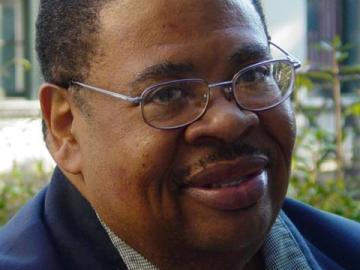
Section Branding
Header Content
Savannah's First Black Mayor "Opened Doors of Togetherness"
Primary Content

Floyd Adams, Jr. was always uncomfortable being called Savannah's first black mayor.
He sometimes corrected people mid-sentence when they said it.
He insisted on being called a mayor for "all the people."
And few tributes could vindicate these declarations better than the multi-colored line of people that filed past his open casket at St. James Catholic Church on Friday.
About 900 people squeezed tightly into every pew to attend his funeral mass, six days after he died at age 68.
They stood at the back of the church.
They arrived early and stayed late.
And they said "Amen" when speakers described "Brother Floyd" as a unifying figure in Savannah politics.
"He was called to be 'the unifier,' the one who reached across racial and cultural lines to bring everyone together," said Fr. Robert Chaney.
"There are so many things that he has done that will live on," said Dana Braun, a Savannah attornery and former alderman. "Floyd was a unifying force."
Adams got that reputation during two four-year terms as the city's top elected officials beginning in 1996.
His mayoral terms were marked by a period of tremendous economic growth in Savannah.
And he was known for being very friendly with the city's business elite.
Some in the city's African-American community gave him flack for this.
Ten years ago, he was being interviewed for an oral history project by the University of North Carolina.
CLICK HERE TO HEAR AN ORAL HISTORY INTERVIEW WITH ADAMS.
This would have been in the last years of his administration.
He talked about the destruction of black neighborhoods, specifically, those that were becoming white neighborhoods.
"People call it gentrification," Adams said. "Is gentrification a good thing or a bad thing? But it's also dealing with the economics of the situation."
This was not a view shared by some in the black community.
His harshest critics saw the rapid development of that period as a threat to African-American history and culture.
Some even questioned his blackness.
This memorably happened during a particularly nasty fight over the inscription on Savannah's first African-American monument.
It's a quote by Maya Angelou on River Street.
He became angry and testy during those exchanges.
But for the most part, his personal style, described by Braun as "quiet and understated," helped people see him as a unifying figure.
His administration focused on drainage projects, keeping homes from flooding.
This was a big issue in many neighborhoods, black and white.
The city also acted agressively against blight back then.
Revitalizating the Martin Luther King, Jr. Blvd. area and other fringe areas became a priority.
Affordable housing rose from out of the ground during his time in office.
And he and other local elected officials made what was probably their biggest decision of all during that decade.
That was the decision to evacuate the entire county for Hurricane Floyd in 1999.
It was called the largest peacetime evacuation in the US until New Orleans got Hurricane Katrina.
And of course, there was the annexation of Hutchinson Island.
That happened on his watch, as well.
But his policy decisions were only a small part of the funeral mass.
Speakers also reflected on his roles as a newspaper publisher, a friend and a family member.
"We lost an icon and a giant of a brother," said Elaine Burns. "He opened doors of togetherness."
He is buried at Lincoln Memorial Cemetery at Hunter Army Airfield.
Tags: Savannah, GPBnews, Catholic Diocese of Savannah, Savannah Mayor, orlando montoya, African-American History, Floyd Adams Jr., African-American, Robert Chaney, Dana Braun
